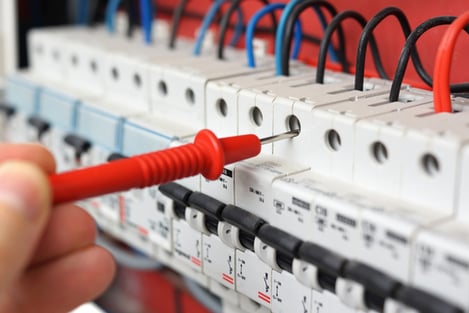 Everyone takes the role of electricity for granted until we’re forced to pay attention. However, what we’re referring to here has nothing to do with power outages but electrical maintenance concerns.
Everyone takes the role of electricity for granted until we’re forced to pay attention. However, what we’re referring to here has nothing to do with power outages but electrical maintenance concerns.
Maintenance is a critical element in ensuring electrical workplace safety. It is also crucial for business continuity and optimising asset ownership. Therefore, ensuring you have an efficiently managed electrical maintenance program is a must as it not only reduces the incidence of accidents but also keeps workers safe.
It also minimises the occurrence of costly breakdowns and unplanned shutdowns that can lead to production problems. With safer and smarter electrical maintenance, impending issues can be diagnosed early on and resolved before they escalate into major problems that typically require costlier, time-consuming repair or replacement.
The importance of regularly checking operating temperature
When you consider how a commercial or industrial facility comprises a huge network of electrical, electronic, process and control, automation and building management systems, you realise just how much equipment depends on electricity and requires electrical maintenance.
In industrial and commercial settings, regularly checking the operating temperature and other key functions of critical machinery assets can help prevent unexpected shutdowns.
In general, the temperature of critical assets is monitored only a few times a year through periodic check-ups. An in-house maintenance team or third-party contractor is usually tasked to hold scheduled or bi-annual thermographic inspections.
However, the frequency of inspection is best determined after mapping the assets and dividing them by equipment families. During the asset inventory, make sure to compile notes on:
- Manufacturer’s recommendations concerning equipment maintenance (e.g., frequency of inspection and maintenance, ideal temperature, humidity requirements, etc.)
- Any information from previous inspections, repairs and parts replacement
 With this data, you can determine how often electrical maintenance needs to be done — whether several times a week, weekly, every month, bimonthly, quarterly, bi-annually or annually.
With this data, you can determine how often electrical maintenance needs to be done — whether several times a week, weekly, every month, bimonthly, quarterly, bi-annually or annually.
It must be noted, however, that these inspections usually take place with the equipment in a de-energised state, except when the assets have infrared (IR) windows. But when switchgear have IR windows, missing critical connection points is possible as there are sections the operator cannot see and which the IR camera cannot detect.
This is why performing preventive thermographic inspections or temperature checks is necessary. With thermographic assessments being done, even low-voltage electrical installation fire-causing failures (that can’t be detected with conventional protection devices) can be diagnosed correctly. Any faults, failures and irregularities detected can then be addressed by licenced electricians or the facility technical team safely and promptly.
Additionally, conducting temperature inspections allows you to catch a critical issue that could manifest itself between inspection schedules and to sort it out. One common example would be finding equipment working above the right or rated temperature — something that could likely reduce the functional lifespan of that particular asset.
Other aspects to consider in determining machinery reliability
 With a hundred and one assets to manage, there are other aspects you also need to consider to determine machinery reliability.
With a hundred and one assets to manage, there are other aspects you also need to consider to determine machinery reliability.
One other way of reliability checking is by monitoring the voltage of medium and low-voltage switchgear, motor control centres (MCCs), transfer switches and other similar equipment. This is because power quality is a critical component that has a direct impact on your equipment and not simply on whether your business will be operational on the whole.
The power provided should meet the needs of each piece of equipment to prevent equipment failure and subsequent downtime. Other consequences of poor power quality include the need for expensive repairs, damage to work in progress, workplace incidents, reduction in or lost productivity, reputational damage and customer loss.
Some common examples of power quality problems include voltage transients, voltage sags or swells, under-voltages, over-voltages, outages, electrical noise, and harmonics voltage. When you experience power quality problems, you need to have them corrected as quickly as possible to reduce or prevent equipment deterioration.
Aside from regular temperature checks and voltage monitoring, other failure-contributing causes you need to monitor are:
- Humidity or the presence of water
- Partial discharges in medium-voltage equipment
- Intrusion or motion
- Vibration of rotating apparatus
- Bus or cable connection point-temperature sensors
- Load current, heater, and fan circuit currents
- Dust trending and the detection of smoke
- Temperature trending (i.e., cubicles, critical cable joints, bus connections, etc.)
Martin Thomas, European Marketing Manager at Radwell International Ltd explains more. “Having real-time insights into the condition of your equipment allows you to issue alerts when unusual temperatures, power quality problems or other failure-contributing causes are detected.
By keeping a close watch on the health of your assets, your maintenance team can schedule routine maintenance, repair or parts replacement whilst preventing equipment breakdowns, unnecessary shutdowns and downtime. Staying on top of electrical maintenance needs also enhances workplace safety and helps your business avoid all the consequences of business interruption — financial and otherwise.”
Stay ahead of the curve
Smart electrical maintenance practices are a critical aspect of commercial and industrial operations as they help keep your major assets intact and increase their functional lifespan.
They also keep you ahead of the curve by allowing your engineers and maintenance teams to address problems before they even begin to manifest themselves, thereby preventing unplanned and costly downtime.
Radwell's iAlert Monitoring Solution tracks the vibration, run-time and temperature of your automation equipment. Eliminate unplanned downtime and improve productivity by ordering yours today! Find out more: https://www.radwell.co.uk/en-GB/Search/?q=ialert









